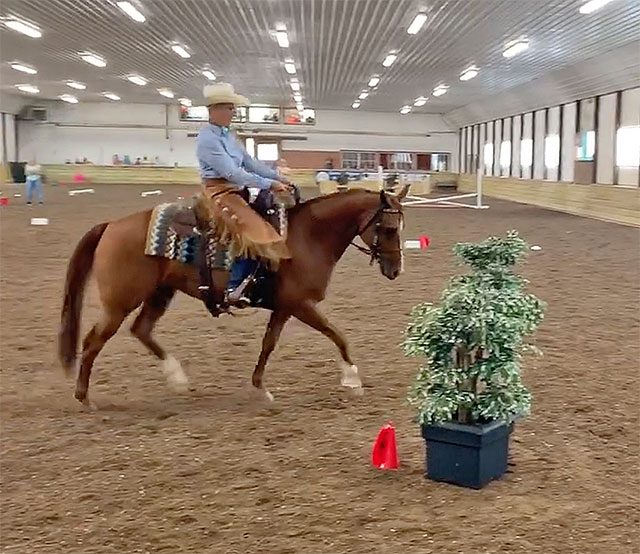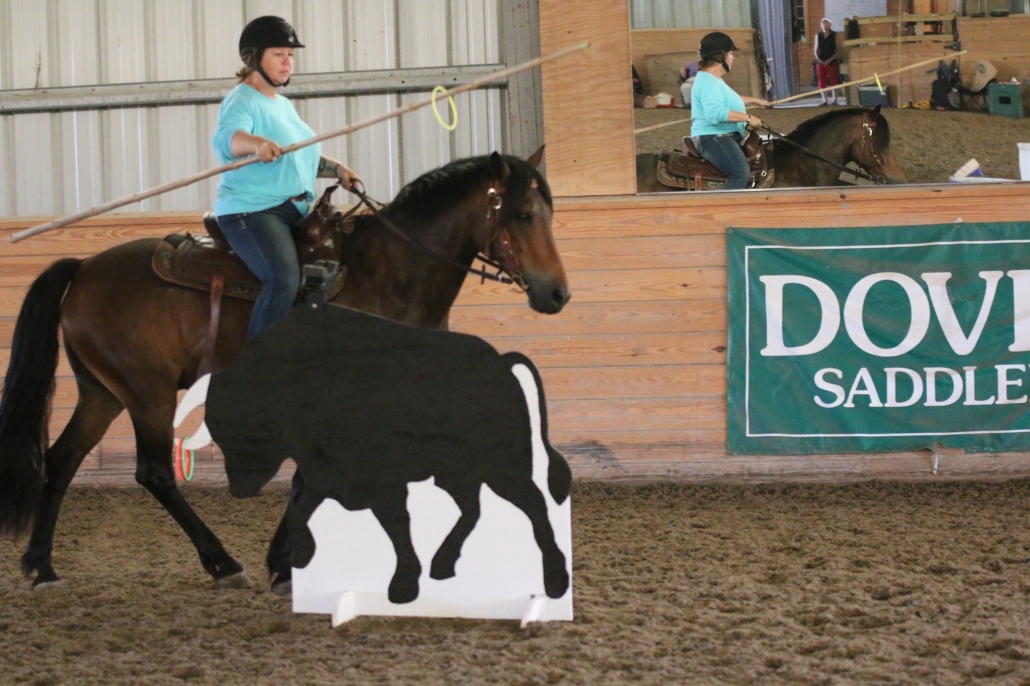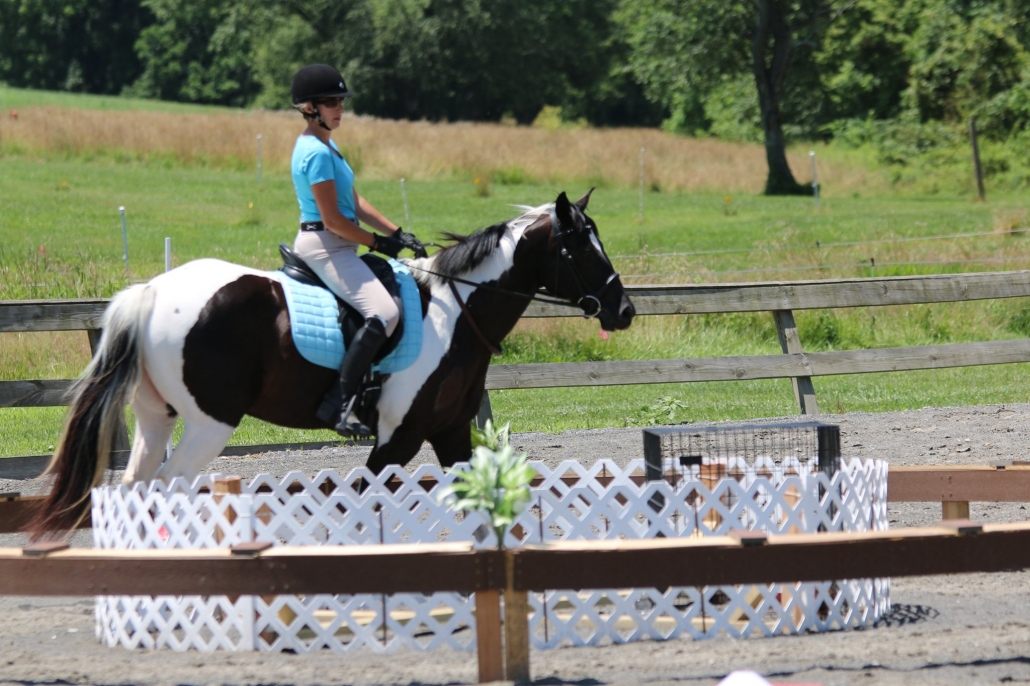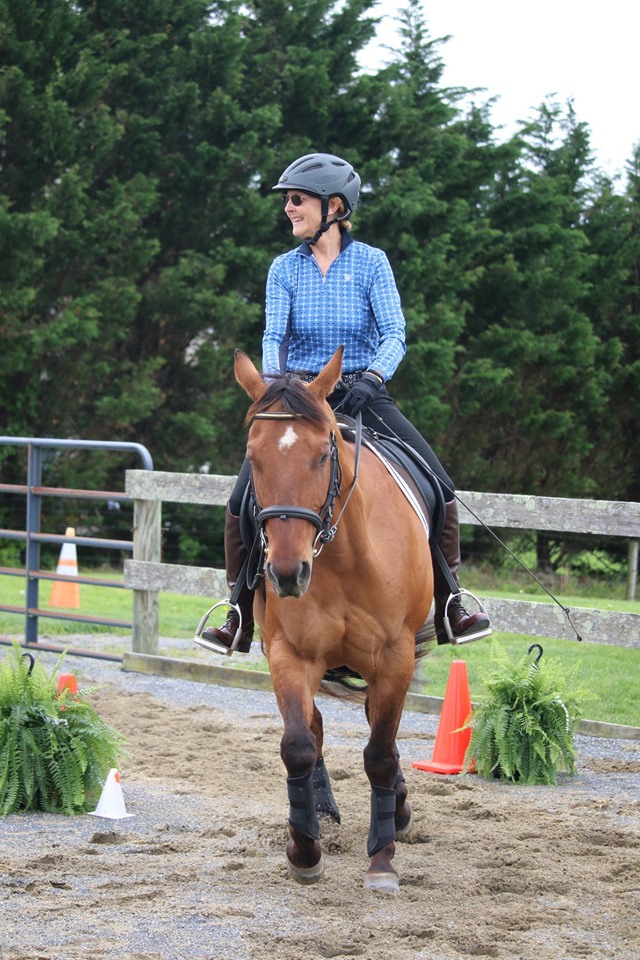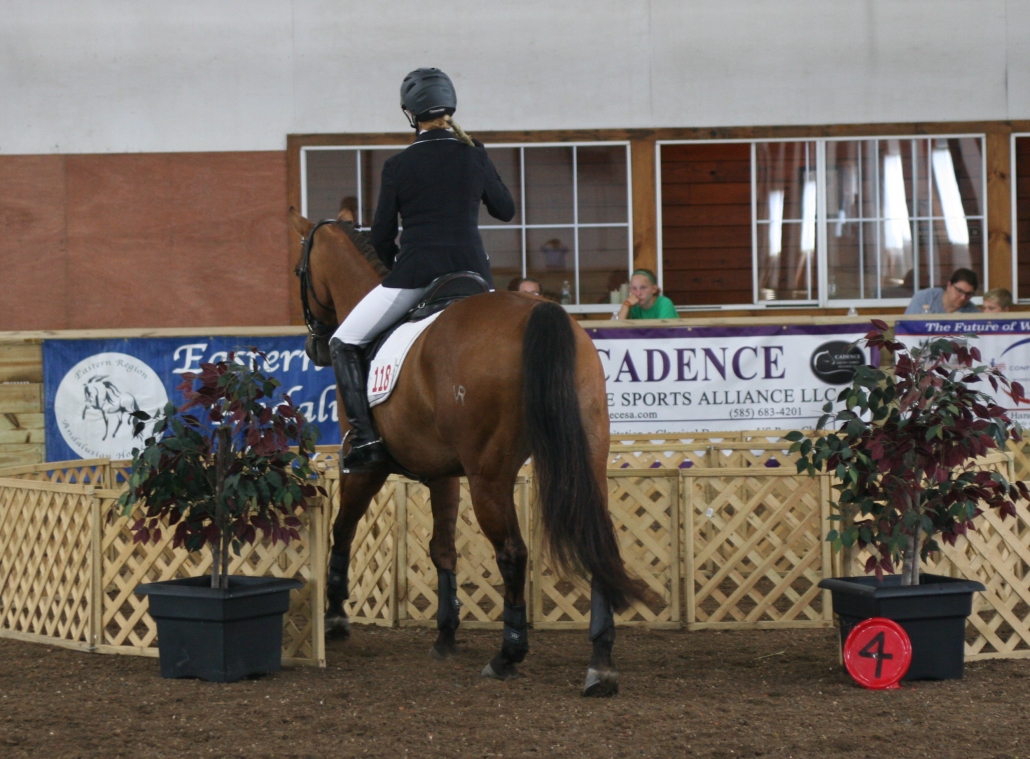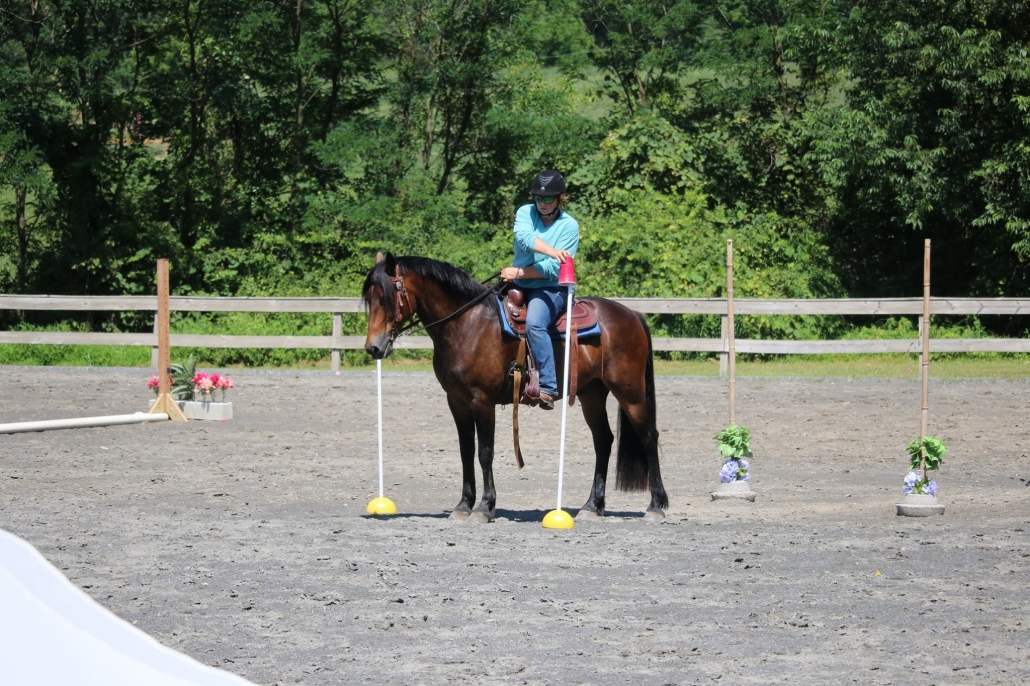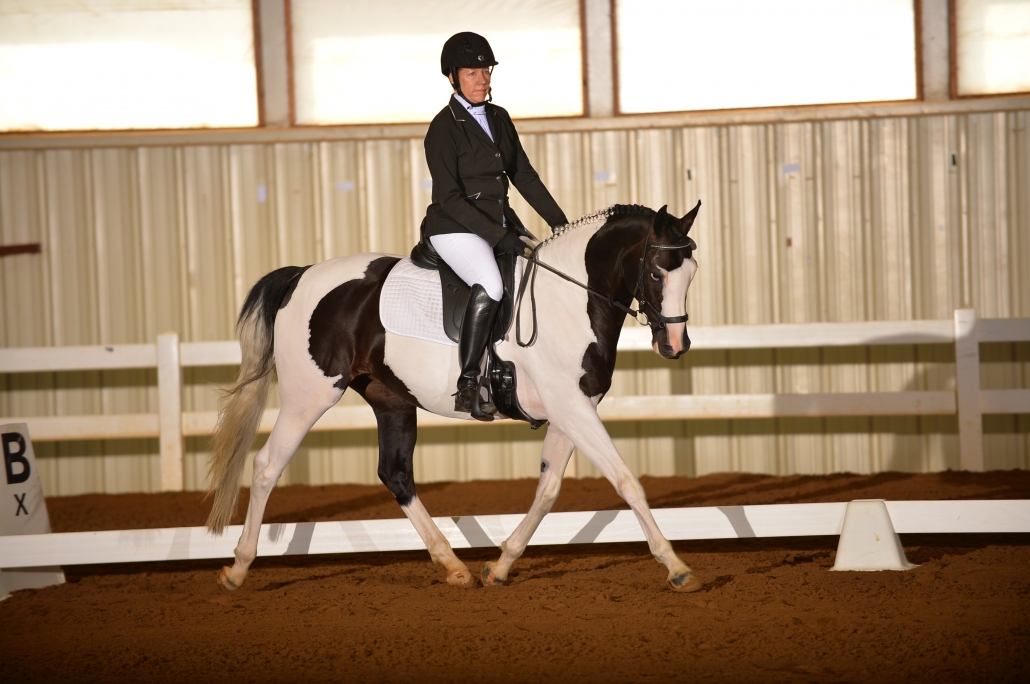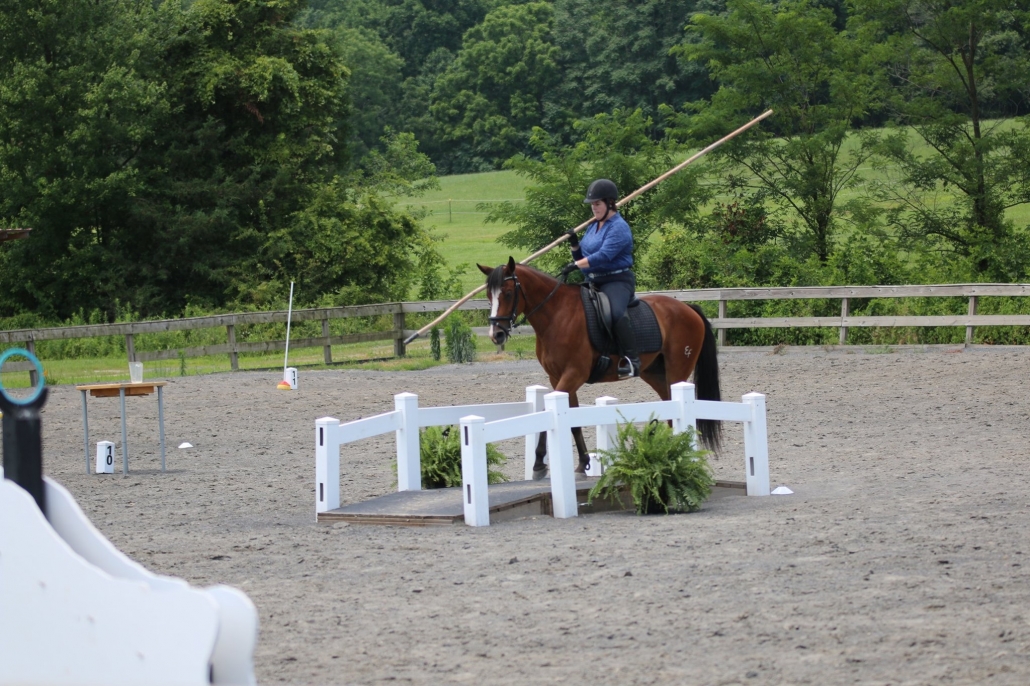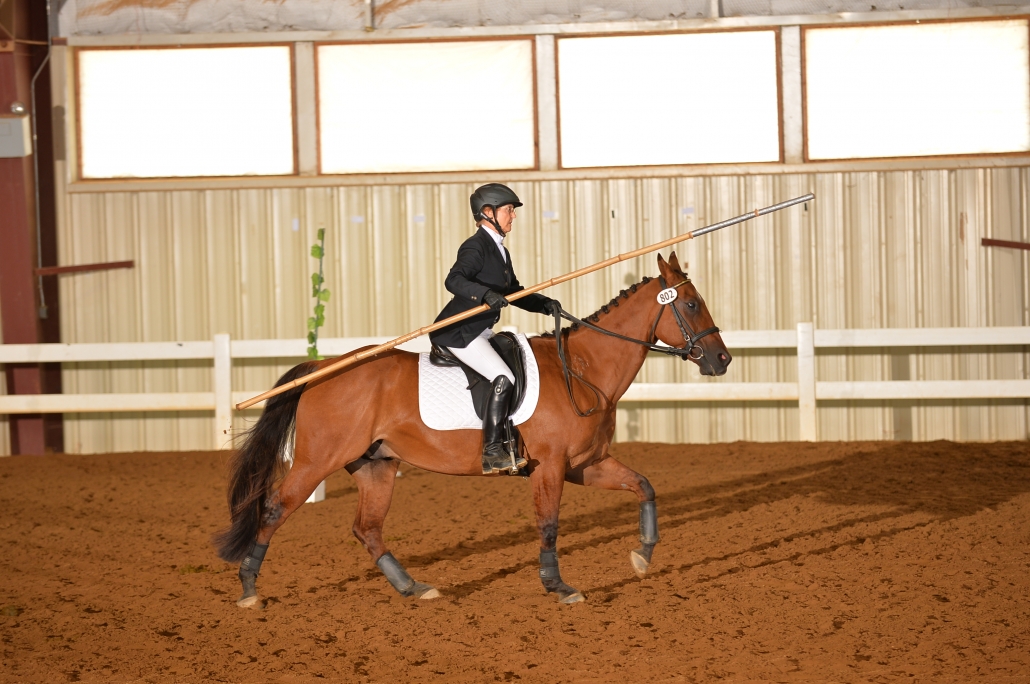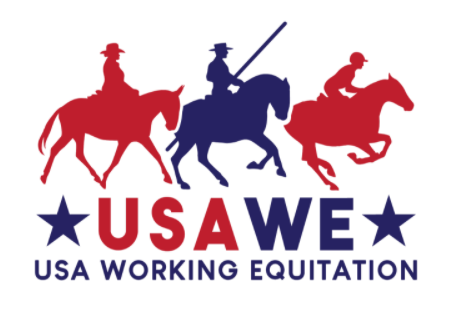Vaccinations: When, Why, How and Which Ones Do I Really Need?
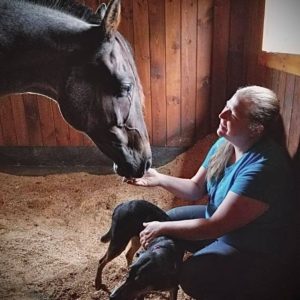
by Jessica M. Williamson, D.V.M.
Associate Veterinarian | Haymarket Veterinary Services
March 23, 2022
The warm days are starting to outnumber the cold, and as we start riding again, we start planning our calendars. With those plans, comes the realization that it’s time to schedule spring shots and Coggins tests. We know we must do them, but why is this a tradition in the spring? Why is this a good idea? What are we vaccinating for? Are they really still needed?
The tradition of giving vaccines in the spring is because many of first group of yearly “required” vaccinations are spread by insects. Many of the insect species can travel several miles, even to the seemingly isolated horse in the backyard or country farm. The other two required vaccinations are spread by wild animals and live in the soil around us, which is why these are also considered required. They come to every horse. Giving these vaccinations in the spring maximizes immunity for the insect borne disease, while limiting frequency of some vaccines for our climate. The second group of vaccines are for risk-based diseases. The need for these vaccinations depends on a horse’s risk of exposure to contagious disease, or lifestyle risks. For contagious diseases it is good to booster for these diseases before our horses are exposed at group outings/shows/camping etc. Again, since traditionally many horses don’t travel over the winter, the timing of spring boosters is a good idea for most of the risk-based diseases. Some vaccinations require 6-month boosters to maintain a protective immunity, resulting in fall vaccinations for these. For horses with unknown vaccine status, all vaccines start with an initial booster series of 2-3 vaccinations before being maintained with 1-2 vaccinations a year (depending on the vaccine). The only exception to this is Rabies. Only a single yearly vaccination is needed in adult horses; there is not an initial booster series required. Vaccines typically take 10-14 days for the horse’s immune system to fully respond and be ready for exposure. This is important to remember when making your vet appointment.
All the diseases listed below are still found in our region and cases are seen every year in unvaccinated horses.
Coggins – a yearly test for Equine Infectious Anemia (EIA), not a vaccine. Equine Infectious Anemia is the only equine disease that is federally regulated and now serves as our horse’s ID card. This started since EIA is a highly contagious and untreatable disease that is spread by biting flies, dirty needles etc. So, this is one that can spread from one infected horse to another if bitten by the same insect. Luckily with development of disposable needles that are cost effective to not reuse, dirty infected needles as a source of EIA is exceptionally rare these days. In the 1970’s over 10,000 horses suffered and died from this disease. Now we rarely see the clinical, often fatal disease of high fever, progressive weight loss and severe anemia. The testing system has worked as it was meant to. Most cases found now show no symptoms at the time of their positive test. If a horse tests positive on its yearly Coggins test, additional tests are run to confirm that it is not a false positive. After a positive test is confirmed, the infected horse is either humanely euthanized or must be sent to an EIA sanctuary miles away from any other horses. Any horse within a mile of the infected horse must be tested several times to ensure there was no spread. Luckily outbreaks are rare, but we have had horses test positive in Virginia in the last 5 years, and there is currently an outbreak in Texas (2022). So, unfortunately, this disease is not fully behind us. This test is required for interstate travel, and normally required for most boarding stables and all shows/horse gatherings/campgrounds.
Rabies – Most people are familiar with this one and may have seen a depiction of this disease on films if not in person. Rabies is caused by the Rabies Virus and is spread via bites primarily from foxes, raccoons, skunks, and bats. It is endemic in Virginia, i.e., it is always here. It is a Public Health Risk; you can get this too, so can your friends and family!!! If you ask around, someone will have a story where they saw an infected wild animal; there is no treatment. If a horse is bitten, then post-exposure vaccinations are given, and the horse is placed in isolation waiting to see if there is a rapid progression of symptoms. Every single person who has handled that horse will need to go through post-exposure vaccination. The rabies virus is a rapidly progressive fatal encephalitis. In horses the symptoms often initially present as colic or the horse that isn’t quite right. It then progresses to either irrational behavior, staggering, and sometimes violence against itself and others. The horse can also present with neurologic signs typical of any other acute neurologic disease and can be very calm and merely be down/not able to get up. There are not always the foaming, water fearing, fierce creatures seen in movies/tv. Unfortunately, the only test to confirm is a Postmortem (after death) examination of the brain. The vaccination is a low-risk yearly vaccination. There is an additional booster soon after known exposure. The time of year isn’t important for this one, but most people give it in the spring with a majority of their other vaccinations.
Tetanus – Is caused by the bacteria, Clostridium Tetani, which lives in the soil. Equines, being pure herbivores that are also highly accident-prone, are at high risk for Tetanus, more than almost any other species. Horses, like us, are exposed through wounds to the skin or foot, even a seemingly superficial wound. Treatment is difficult and rarely successful. Tetanus causes extreme muscle rigor/stiffness to the point the horse is unable to move, hence its nickname of lock jaw. If there is no humane intervention, they suffocate once the rigor reaches the diaphragm. Since they are more at risk than we are, yearly vaccination is strongly recommended. Should they have a wound 6 months after their yearly booster, they will need another booster.
Eastern and Western Equine Encephalitis and West Nile Disease – These three diseases are lumped together since they are viruses that are very similar in many ways. All three are spread primarily by mosquitoes. We do not see Western Encephalitis on the east coast, but it is always paired with Eastern Encephalitis in vaccinations. These are all viruses that cause encephalomyelitis i.e., inflammation in the brain and spinal cord. They are characterized by sudden onset of high fever with neurologic symptoms. The horses are often depressed, can progress to ataxia (staggering around as if drunk) and then recumbency (inability to stand). With all three viruses, once they are down and not able to get up, they rarely survive. There is no cure, and the only treatment is prompt supportive care and anti-inflammatories to decrease the inflammation in the brain and spinal cord when symptoms develop. After that it’s watch and wait to see if they recover. Eastern Encephalitis and West Nile are still found in our resident mosquito population. For Eastern and Western Encephalitis, yearly vaccination is recommended for our area since most of the time we do have a severe enough winter. In states with warmer climates south of us, vaccination is recommended twice-yearly due to extended mosquito season and higher incidence of disease. West Nile Vaccines are typically given twice due to vaccine labeling and a higher incidence of this newer disease in our area.
Potomac Horse Fever (PHF) – This is a disease that is regional and was first recognized in Northern Virginia. Some older horsemen and vets in the area can tell you horror tales of the original outbreak. While being close to a water source was quickly recognized as a risk and the fact that the bacteria Neorickettsia risticii was found in snails, it wasn’t until 1995 that we finally found the primary culprit, aquatic bugs, especially the Mayfly. Infection is caused by ingestion (eating) of the Mayfly. Typically, this water bug is attracted to light sources, dies, falls into where horses eat or drink, and then is ingested since it is rather small. Because it is a regional disease, there are not many vaccine options, and this is a prime example of where vaccination is not perfect at preventing disease. In other parts of the country that may have different variants of this bacteria, the vaccines are not as effective. Lucky for us, it was developed off the bacteria in our original outbreak and therefore is more likely to be effective here. While not perfect, a majority of vaccinated horses in our area will be less ill and more likely to survive. Symptoms of PHF include high fever, diarrhea, decreased appetite, followed by possible laminitis. This diarrhea can be so severe these horses are difficult to keep hydrated, even on 24-hour IV fluids. The GI inflammation can lead to sudden onset of severe and fast progressing laminitis that is difficult to stop. Typically, vaccinated horses may have a fever and/or mild diarrhea, and rarely do they progress to the illness described above, especially if treated promptly. The treatment is prompt administration of IV Oxytetracycline. This is one of many reasons high fevers in our area are treated with this antibiotic until diagnostic tests or other symptoms prove its something else.
Influenza – The flu for horses is very similar to our flu. Luckily, we don’t share flu viruses as they are species-specific. Like our flu, horses have high fever, sometimes a nasal discharge and a severe dry cough which can progress to pneumonia. Like us, typically, the flu lasts longer than your typical “cold” with the cough lasting up to a month. Since the lungs can be affected, the horses are sometimes encouraged to rest for several weeks while they recover. Like us, the young and old are more at risk, as are those that are traveling or live in boarding/training barns with horses that come and go a lot. Vaccination is effective for many, and if not fully effective, can certainly reduce the spread of disease and time of illness. This vaccine is given twice yearly for those traveling year-round or in boarding situations. If you travel seasonally and have a small farm without other horses close by, you can time this for once a year. The vaccine is most effective for about 6 months. Flu is highly contagious and being aerosolized spreads rapidly for fairly long distances, 10 -20 feet, and some reports claim up to a mile. This is one of the harder outbreaks to contain because of this. It also can live on objects and clothing. Handwashing, showering, disinfecting used objects, and a change of clothes and footwear are recommended if you are possibly exposed, before seeing horses that are not sick.
Rhinopneumonitis – Equine Herpes Virus 1 and 4 – This one comes with several nicknames that are used interchangeably. These included Herpes, Rhino and EHV. There are 5 recognized Equine Herpes viruses. 1 and 4 are the most likely to cause clinical disease that is significant to the industry. 1 and 4 most commonly cause respiratory infections and can cause abortions in pregnant mares. “Rhino” respiratory viruses typically present as what we would call a cold. Typically mild, but sometimes horses have high fevers, with upper respiratory signs (head cold), nasal discharge, cough, decreased appetite, and lethargy. Especially in the vaccinated horse, this is typically short-lived. It is spread by nose-to-nose contact/closer proximity/cough and touching of shared objects. This virus does live on surfaces and hands for a short period of time and is a good reason not to go down a row of show stalls and pet all the horses. It has the same recommendations as with the flu for preventing spread. The vaccine is pretty effective for the Respiratory and Abortive versions of this virus. Over the last 10-15 years EHV 1 has been in the news due to a genetic variation/mutation of the virus that has led to outbreaks of severe and sometimes deadly neurologic disease. This variation normally has a fever, followed by quickly progressing ataxia over the next couple days, sometimes after the fever has resolved. Luckily there are some very classic symptoms that will make a vet suspect, and there is a fairly rapid (a day or two) nasal swab test if this is suspected. These outbreaks are not frequent, but there are typically several each year located somewhere in the US or around the world. This newer mutation and its clinical presentation are referred to as Equine Herpesvirus Myloencephalitis (EHM). Unfortunately, along with more severe disease, this mutation/variant is also more contagious. This is the reason that the Flu/Rhino vaccine is required by many shows and facilities within 6 months of the show. Unfortunately, the vaccination is not highly protective for the neurologic form, but it offers some protection and possibly reduces nasal shedding of the virus in the sick, i.e., if all horses at a show or barn are vaccinated the outbreaks can be easier to contain. Some Rhino/EHV 1 vaccines are thought to be more likely to offer some protection against the neurologic form than others. If you are showing in situations with large numbers of horses that frequently travel you may want to discuss with your vet your plans and what vaccine is recommended for your situation and risk. Unfortunately, this risk isn’t purely for the widely traveled. Like any Herpes virus, once a horse is stressed, the virus can be reactivated in a horse’s body. Since most horses are exposed at some time in their younger years, this is a risk for just about any horse that we can’t do much about. The main thing to understand is that this explains some of the rare EHM outbreaks in farms with no record of recent travel. Even if your horse has classic symptoms and hasn’t traveled, it is still on the rule out list. This vaccine is given at least yearly for horses at risk of exposure, but for those at year-round risk, every 4-6 months is recommended.
Streptococcus Equi/Strangles – Most horse people have heard of Strangles, and it has a well-deserved bad reputation; an outbreak in a barn, if not well managed, can lead to long term quarantine and shut down of any travel on or off the farm for many months. Strangles has many similarities to our own Strep Throat. Luckily, we cannot give Strep to our horses, and only in exceptionally rare instances with immune compromised individuals, has this bacterium been shared between a horse and its person. Like our strep throat, it is an infection of the back of the throat/larynx/pharyngeal area. It can get into the lymph nodes and cause abscesses, which cause the famous large swelling behind and under the jaw. In one of its worst forms, it can affect the lymph nodes directly around the throat, which can cut off the airway, which leads to its nickname of Strangles. It can also cause hidden abscesses in other lymph nodes in the body, that can become walled off causing what is called Bastard Strangles. Most horses have a fever, copious nasal discharge, a sore throat/decreased appetite, then as it progresses, they can develop the Lymph Node abscesses under and behind the jaw. Untreated, the disease can take weeks to over a month for the horse to fully recover. They are contagious for at least 3-6 weeks after all resolution of symptoms. Often testing is recommended to confirm the horse is no longer contagious before it is allowed out of quarantine. Strangles is caused by the bacteria Streptococcus Equi which is spread by shared water source, nose to nose contact/close proximity, and can live for very short times on objects/clothes/hands/boots, etc. Refer again to recommendations listed under influenza to help prevent spread. It used to be believed that it lived in the soil for a long time, however that has since been disproven. Infected horses are sometimes treated with antibiotics (if caught early or if severely sick), or sometimes the infection is allowed to run its course with supportive care only. Treatment depends on the stage of illness when diagnosed and the ability of the horse to weather the infection. Once abscesses have formed, antibiotics are contraindicated as they can prolong disease as well as make Bastard Strangles or a carrier state more likely. Once the lymph nodes are draining, then antibiotics can be used if needed. If the horse is not treated with antibiotics, they will often maintain high immunity for a very long time after recovery. Infected horses are at risk of becoming long-term carriers with hard chunks of old pus, called chondroids, in their guttural pouches. When these are present in the guttural pouches, the bacteria can then be shed during times of stress. Since the shedding horse rarely appears sick, they can go around for a long time unsuspected, and cause random out breaks in seemingly quiet horse situations. The chondroids can be removed once found, but the veterinarian must first determine which horse is infected and scope the guttural pouches to find the chondroids.
Vaccination comes in two forms and are administered yearly. One is a killed vaccine that is administered intramuscularly. The other is a modified live vaccine that is administered intranasally (i.e., up the nose). If you are vaccinating for Strangles, you should speak to your vet about which vaccine is most appropriate for your situation and your horse. If your horse has an unknown exposure or vaccine history, is reactive to vaccinations in general, or has had yearly vaccinations for strangles and /or is older, then a Strep Titer is strongly recommended. This is one of the few vaccinations where titers are well researched enough to have very clear guidelines for titer interpretations. This titer can determine your horse’s immunity level and if vaccination is needed and safe. The main reason we know so much about Strep Titers is because if a horse has high immunity to Streptococcus Equi, they are at risk for a life-threatening immune reaction called Purpura Hemorrhagica if they are exposed to it again either naturally or via vaccination. Purpura Hemorrhagica is an immune-mediated vasculitis that can be fatal. Many years ago, Strangles was rare in our area. However, with the influx of horses from across the US, especially ones saved from kill auctions, we have had a significant uptick of outbreaks. If you have a new horse coming in from an unknown situation, speak to your vet and barn manager about if quarantine is recommended and/or what testing is recommended
Botulism – Clostridium spp. Botulinum Neurotoxin. These bacteria can grow in any rotting living matter, either animal or vegetable/plant. The disease is caused by the toxin released by the Clostridium Botulinum, so even long after the dead animal or rotting vegetation is removed, the toxin will remain. This is a regional risk for Kentucky and the Mid-Atlantic States. Virginia is at the southern range of where this is at higher risk. Symptoms are muscle weakness, paralysis, inability to swallow, recumbency, and frequently death. While Botulism and Tetanus are caused by bacteria in the same family, their symptoms are nearly polar opposites. There is a yearly vaccination for this one, after an initial booster series of three shots. Most often it is given in the fall, due to higher risk with round bales since you don’t always see what is in them. The treatment is an antitoxin given as soon as an infection is suspected, followed by supportive care. Typically, this care is given in a hospital, as the care required can be very intensive. Survival depends on the amount of toxin dose ingested by the horse, versus how quickly treatment is initiated. On the plus side, since we are in the southern range, this is not a frequent disease that we diagnose here. It’s just very traumatizing for everyone when we do see it.
Lyme Disease – Lyme disease is caused by the bacteria Borrelia burgdorferi. This is a disease most of us are familiar with as we, our horses and our dogs are all equally at risk. It is one of several endemic tick-borne diseases in our area and is the only tick-borne disease there is a vaccine for. It is also the only tick- borne disease that tends to hide from the immune system, causing a chronic form that can wreak havoc. Unfortunately, our horses do not have the classic bulls eye ring that we get around the infected tick bite. The deer ticks that spread Lyme are tiny as a pinpoint, black and hide well on the horse’s dark skin especially up in the warm areas of the tail, mane, groin and under the jaw. Acute Lyme Disease has a high fever, with concurrent lethargy. The most common symptom I have seen in those horses that don’t spike the fever, is a behavior change of some kind, the bully becomes sweet, the sweet horse is grumpy, the horse is generally checked out or suddenly spooky when they were always rock solid before. The second is sensitivity to touch, no longer liking to be groomed, sometimes progressing to not liking to be touched at all. Other symptoms can include top line loss, muscle soreness, shifting lameness, or unexplainable lameness that evades typically diagnostics, swollen joints, neurologic symptoms, and uveitis. This list is not fully complete but includes most of the common presentations. There are a couple tests for Lyme Disease including an on-farm snap test and the more gold standard Lyme Multiplex antibody test. Vaccination for Lyme Disease has some controversy. There have been several studies by this point using a couple of the Lyme vaccines on the market for dogs. Unfortunately, there is not enough industry pressure, since this is a regional disease, for us to have received a labeling for use in the horse. As Lyme Disease and the ticks that carry it spread across the US, there are increased rumors of us getting an equine labeled product, however it has not happened yet. The studies that have been done have shown the vaccine to have low risk of side effects and to offer some protection. In our practice the need for treatment of Lyme Disease went down significantly once we started using the vaccine within our practice. Different vets have different views on this, so if you haven’t discussed with your vet and are interested, have a discussion of risks, cost and if appropriate for your horse. One big thing to know is that since it is a vaccine that is not labeled for use in horses, the vaccine company will not cover the cost of vaccine reactions or of vaccine failure. These benefits are often offered by vaccine companies on all the other vaccines listed above, which are labeled for use in horses. This coverage is offered only if the vaccines are given by a veterinarian, so the company knows that the vaccine was appropriately handled and administered as labeled.
Vaccines are always a personal choice for you and your horse. Which vaccines you decide to give should be a discussion with your veterinarian. Hopefully you now will have a better understanding of why your vet may make certain vaccine recommendations for your horse, as well as what info is good for your vet to know when helping you decide which vaccines are needed. If you do plan to be out and about, and you are not able to give some of the risk-based vaccines for any reason, you can also discuss with your veterinarian the best ways you can protect your horse when out in public. I hope this information has been helpful, and I hope to see many of you out and about having lots of fun this year! Happy trails and travels!
Press Release – New Equestrian Organization Formed in Northern Virginia
Contact Diane Hutchinson
703 727-3494
FOR IMMEDIATE RELEASE, July 29, 2019
New Equestrian Organization Formed to Develop Sport of Working Equitation in Northern Virginia Area
Northern Virginia supports many communities laden with horses and equine activities making the area perfect for the addition of the new Northern Virginia Working Equitation (NOVAWE) organization. NOVAWE is a new non-profit member organization with a mission to promote growth of the exciting Working Equitation (WE) equestrian sport through education and mounted events. WE has origins in European and South American ranch work, and the sport welcomes all breeds and disciplines to participate in its dressage-based, approach to arena obstacle execution.
There aren’t yet many WE shows in the Northern Virginia area, but NOVAWE is working to change that. NOVAWE President Elizabeth “Biddie” Lowry, Gainesville, VA, put on two Play Days, four Clinics and one Ease of Handling Schooling Show in Prince William and Loudoun Counties over the last year. Her popular Facebook page, Northern Virginia Working Equitation, has over 250 members. There she posts all kinds of useful and instructive information to help those interested in WE, including information on how to join NOVAWE. Also, the club is building a website to be open soon www.NOVAWE.org to provide members and all interested parties information.
The best part about learning WE is it’s fun for both horse and rider and therefore a favorite for cross training all horses, from trail horses to Grand Prix dressage horses and top jumpers, as well as Western style horses. The mental challenge of obstacle work provides the horse a welcome change from his regular work – most horses embrace the obstacles happily.
Before attempting a WE show however, NOVAWE will provide opportunities to learn not only how to navigate the 22 different WE obstacles, but also to understand the ample rules of WE. NOVAWE offers those just interested in improving their horsemanship and precision through WE practice opportunities through its introduction events and Play Days.
For those that develop ambitions for WE competition, NOVAWE will prepare members for the three phases of trials. First is to ride a WE dressage test, followed by an area obstacle course where each of at least 10 obstacles, and the transitions between them, are scored with value between 0 -10, plus collective marks. A third trial is the obstacle course ridden for speed, fastest time wins, penalties get converted to seconds.
The Children’s Level as well as the Intro Level (Level 1) are Walk-Trot levels and do not participate in the Speed Trial, but Levels 2 through 7 do participate in the Speed Trial. A WE show can offer a fourth trial, the Cattle Trial. This is a team event working with cattle and can also be offered for individuals.
Dressage (which literally means training) work is important for any horse. Couple that with obstacle execution and the results will be increased precision, useful in any discipline – from foxhunting to show hunters. Transitions become crisper, and navigation improves. WE is great cross training for all horses, including those who ride in other obstacle and pattern competitions from Judged Pleasure Rides to Ranch Riding.
While WE is prevalent on the West Coast, its popularity is spreading East and NOVAWE organizers Lowry, Gainesville, VA, Diane Hutchinson, Leesburg, VA, and Laura Guillaudeu, Hillsboro, VA are teaming to help the sport’s growth along.
“My horse, who I compete in lower level United States Dressage Federation (USDF) dressage schooling shows, loves to walk into an arena and see the WE obstacles,” said Hutchinson. “Her ears go up, and I know she is thinking ‘Oh boy, obstacles, fun!’” Hutchinson has competed in two rated WE shows, but both were over a three-hour distance away. She is anxious to help grow the sport right here in her Loudoun County and the surrounding areas. “With such a large and active sport horse community where we live, we can support and offer numerous WE events locally.”
Guillaudeu agrees. She was introduced to WE through Tri-State Riding Club who offered some WE lessons last year. “I’ve been hooked ever since, and I’ve ridden in every event NOVAWE has put on,” she said, adding that she is excited to help NOVAWE advance WE by volunteering to serve as its membership coordinator. Many folks NOVAWE introduced to WE through Play Days and Clinics feel the same – they love WE and want to do more.
Truly WE has something for just about everyone. “It is so fun, first of all. My mare Skye loves it!,” said Adair Soho, who rides a reining mare. “I never started with Working Equitation thinking it would become my thing, but I love it and my horse loves it,” she explained. “And I love all the wonderful and supportive people I’ve met.” Soho’s Another Turn Tack Shop in Purcellville, has joined NOVAWE as a business member. Soho participates in mounted events and represented NOVAWE in July at the rated WE Eastern Region Andalusian Horse Club (ERAHC) show at Birchtown Stables in Forest City, PA where she won the Level 1 Intro Amateur Grand Championship.
All six of the NOVAWE riders that attended the July Pennsylvania WE show were successful. Lowry, who won the Novice A Amateur Dressage and Ease of Handling trials on her registered Quarter Horse Oliver Red Tari accredits the NOVAWE team’s success to their thorough preparation and knowledge of WE, something NOVAWE stresses in its clinics. “ I can’t thank Allison Reed of Bella Vita Stables in Catharpin, VA enough for her instruction and training at all of the clinics. Reed is a regular NOVAWE clinician/trainer and has coached all the NOVAWE riders. “I’m proud the NOVAWE riders were so well prepared and successful in Pennsylvania,” said Lowry, who is already busy coordinating more practice and clinics for NOVAWE riders to prepare for the next rated show at the Virginia Horse Center August 24-25th.
Simultaneously NOVAWE is kicking off a membership drive and also putting on demos for Pony Club camps and conducting Play Days for those who have not yet been introduced to WE. If you’d like the NOVAWE team to show your barn or organization how to try WE, contact Biddie Lowry [email protected], visit NOVAWE’s Facebook page Northern Virginia Working Equitation, or go to the website www.NOVAWE.org (currently under construction).
Releasable Photos and more information available.
Diane Hutchinson on Splash of Glory
Biddie Lowry on Oliver’s Red Tari
Northern Virginia Working Equitation
Upcoming NOVAWE Events: Member WE Schooling Day at Bella Vita Stables August 14 NOVAWE Wednesdays August 7, 14, 21 ERAHC VA Classic, Rated WE Show, Lexington, August 24-25 NOVAWE Clinic with Allison Reed, Bella Vita Stables 9/14
NOVAWE MISSION:
Northern Virginia Working Equitation is a member club dedicated to promoting the growth of the equestrian sport of Working Equitation in Northern Virginia and the surrounding areas through education and Working Equitation (WE) activities. This organization welcomes all equestrian disciplines, offers opportunities to advance mounted skills and knowledge of WE, and encourages the development of a harmonious relationship between horse and rider.
THE SPORT WE
WE has something for everyone – The name Working “Equitation” is defined as the art or practice of horse riding or horsemanship. Hence working equitation is for everyone- English, western, Spanish vaqueros, gaited, as well as any breed, any age, any ambition. There are seven levels to progress through and riders from all disciplines participate together which makes it super fun.
Whether you are just interested in acclimating your horse to obstacle work in our Playdays or becoming a serious competitor in WE can help you accomplish, NOVAWE can help you accomplish your WE goals.
For those wanting to become competitive in WE, learning to ride the obstacle trials well leans heavily on dressage training – bending, impulsion, transitions, changes in direction (and leads) – all of it “smooth, light and in balance” in the Ease of Handling Trial and “fast and careful” in the Speed Trial.
Spotlight
What better place than Northern Virginia, with its wealth of horses and people who love and compete them, to organize this all inclusive amazing sport.
There are seven levels to progress through and riders from all disciplines participate together which makes it super fun. The name Working “Equitation” is defined as the art or practice of horse riding or horsemanship. Hence working equitation is for everyone- english, western, spanish vaqueros, gaited, as well as any breed, any age, any ambition.
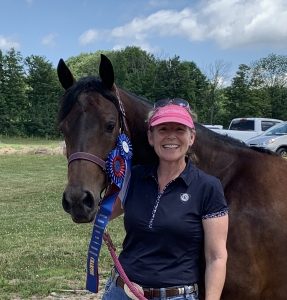 Member Adair Soho’s story is similar to a lot of Working Equitation (WE) enthusiasts, she was introduced to WE through a NOVAWE Play Day and caught the WE fever. “It is so fun. My mare Skye loves it!,” said Soho, of her reining-bred mare that shows as Cromeless Mercedes. “I never started with Working Equitation thinking it would become my thing,” she explained, “but it has.”
Member Adair Soho’s story is similar to a lot of Working Equitation (WE) enthusiasts, she was introduced to WE through a NOVAWE Play Day and caught the WE fever. “It is so fun. My mare Skye loves it!,” said Soho, of her reining-bred mare that shows as Cromeless Mercedes. “I never started with Working Equitation thinking it would become my thing,” she explained, “but it has.”
Soho went to her first rated show in July, the Eastern Region Andalusian Horse Club (ERAHC) show at Birchtown Stables in Forest City, PA where she won the Level 1 Intro Amateur Grand Championship. Soho, was in good company as five of her fellow NOVAWE friends also competed in Pennsylvania, bringing home a lot of good ribbons (quite a few of them blue and tri-colored,) and big smiles, “And I love all the wonderful and supportive people I’ve met,” Soho said of NOVAWE. (See related story/press release under NEWS.)
Soho’s Another Turn Tack Shop in Purcellville, (she is co-owner with Karen McCarthy) has joined NOVAWE as a business member and has been supportive since her first effort with a garrocha pole. Soho also heads up NOVAWE Youth Committee and can always be counted to bring humor and her Loudoun County equestrian-wide experience to help NOVAWE. “When you spend as much time in a tack store as you do a barn, you get to know about all the disciplines and all the local people,” said Soho, who can help patrons with everything from saddles to boots to excellent horse care products.
NOVAWE members be sure to support all our business members. Visit Another Turn Tack at 701 E Main Street when your in Purcellville. NOVAWE Members will receive a 10% discount (exceptions apply), just show your NOVAWE membership card, or photo of it. Another Turn Tack will price match and if they don’t have what you are looking for, they will order it for you.
Graciously, Another Turn Tack Shop has offered their building to NOVAWE to host our first member meeting September 28th so save that date.
https://anotherturntack.com/ and like them on facebook.

